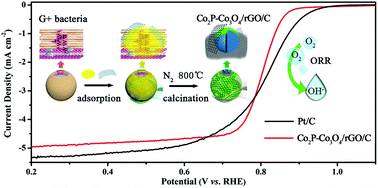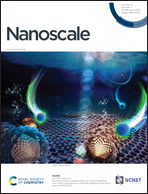Facile in situ fabrication of biomorphic Co2P-Co3O4/rGO/C as an efficient electrocatalyst for the oxygen reduction reaction†
Abstract
Streptococcus thermophilus, a Gram-positive (G+) bacterium featuring a teichoic acid-rich cell wall, has been employed as both a phosphorus source and template to synthesize a biomorphic Co2P-Co3O4/rGO/C composite as an efficient electrocatalyst for the oxygen reduction reaction (ORR). Different from the conventional method for the synthesis of phosphides, bio-derivative phosphorus vapor was emitted from the inside out, which facilitated the in situ transformation of the chemically adsorbed Co precursor on the bacteria into Co2P-Co3O4 heterogeneous nanoparticles, which featured a Co2P-rich body and Co3O4-rich surface. Besides, reduced graphene oxide (rGO) was also introduced in the synthetic process to keep Co2P-Co3O4 scattered and further promote the electron transport efficiency. All the Co2P-Co3O4 nanoparticles and rGO sheets were supported on the bacteria-derived carbon substrate with submicron-spherical morphology. The as-obtained Co2P-Co3O4/rGO/C composite exhibited excellent electrocatalytic performance for ORR with onset and half-wave potentials of 0.91 and 0.80 V vs. RHE, respectively. Furthermore, its long-term stability and methanol tolerance were better than those of commercial Pt/C. Thus, this work presents a new strategy of using an interior bio-phosphorus source to obtain heterojunction particles featuring a phosphide-rich body and oxide-rich surface, which may provide some insights for the construction of efficient heterogeneous electrocatalysts.

- This article is part of the themed collections: Nanoscale 2021 Lunar New Year Collection, 2020 Nanoscale HOT Article Collection and Nanoscale Most Popular 2020 Articles


 Please wait while we load your content...
Please wait while we load your content...